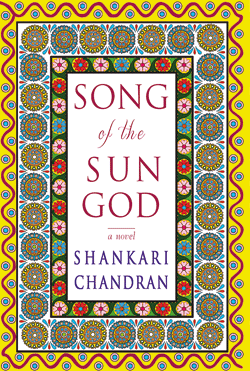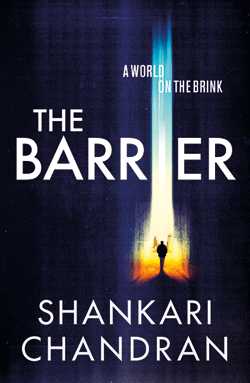Weaving in the Lankan connection from without

Shankari Chandran: “There are multiple narratives”
In 2015, Sam Perera of Perera-Hussein Publishing House picked up Shankari Chandran’s manuscript from the publishing house’s to-read pile and chucked it inside his bag, vowing to read it whenever he had the time on a trip out of Colombo. While thumbing through the manuscript, he found himself unable to put it down and devoured it over a weekend.
The book that emerged earlier this year by the Australia-based author and Sri Lankan publisher tells the tale of three generations across three continents, dissecting the complexities of family, identity and nationhood. Dotted with wonderfully flawed and endearing characters tangled up in Sri Lanka’s tumultuous history, Shankari Chandran’s Song of the Sun God (SOTSG)is a sensitive, fast-paced read and easily a noteworthy addition to Sri Lankan English fiction.
Raised in Canberra, Australia, Shankari worked as a lawyer in London for ten years and now lives in Australia with her husband and four children. Having just released her second book The Barrier – a political thriller set in 2040 Sri Lanka in a world recovering from an Ebola pandemic and a religious war – Shankari is currently at work on a third. She caught up with the Sunday Times over email to discuss the importance of multiple narratives, the legitimacy of the diaspora to write about Sri Lanka and cameos in fiction.
- Could you share some of your experiences with Sri Lanka? Did you grow up here? If yes, are there any memories of Sri Lanka which have stayed with you over the years?
I grew up in Australia but Sri Lanka feels a part of me because my parents’ and grandparents’ memories are so vivid. I spent my childhood eavesdropping on their conversations and then in my adulthood they enjoyed my fascination with their past, and shared their memories generously.
Before 1983, my cousins and I spent summers in Sri Lanka, playing in my grandparents’ home in Colombo. I remember sitting on the doorstep, all of the cousins assembled like little birds, waiting for my uncle’s old Ayah to make balls with the rice and curry and throw it into our mouths. I remember the smell of my grandmother’s face (Oil of Ulay) mixed with the smell of her hands (oil paints).
I remember being wedged between cousins, in the back seat of my grandfather’s Morris Minor as we drove from his house to Wellawatte to visit more cousins. I loved those summers.
- What was an early experience where you learned that literature had power?
 To Kill a Mockingbird is my favourite book. It moved me as a child and it still moves me. Whenever I travel for long periods of time I carry it with me. It set me on a career path (to become a lawyer) and later I realised that I was probably responding to Harper Lee’s style of storytelling as much as I was the idea of justice. Harper Lee gives us Scout, precociously observant, but still painfully confused by man’s cruelty.
To Kill a Mockingbird is my favourite book. It moved me as a child and it still moves me. Whenever I travel for long periods of time I carry it with me. It set me on a career path (to become a lawyer) and later I realised that I was probably responding to Harper Lee’s style of storytelling as much as I was the idea of justice. Harper Lee gives us Scout, precociously observant, but still painfully confused by man’s cruelty.
- How did your work in social justice and law inform your writing?
My work has had a huge effect on my fiction writing. As a lawyer, I was exposed to the worst kind of human behaviour, our selfish and savage side. I was also exposed to the best kind of behaviour, our brave and just side. I watched the moral compromises people make, those subtle shades of grey that exist between the binaries of good and evil. My characters reflect these shades.
Working with incredible organisations like the International Committee of the Red Cross helped me understand the role and limitations of humanitarian law in conflicts. The law tries, people try, but often they fail. Those failures are always accompanied by immense human suffering. I’ve tried to highlight that suffering and honour those who try to stop it, in my writing.
As a lawyer, especially post 9/11, I was very interested in the way governments changed laws in order to ‘protect’ society. Some of these laws undermined our civil liberties. That tension and quiet erosion of certain rights, also feature in my work.
- Could we discuss the Mahabharatha references/links in the book – what prompted this?
I would love to discuss the Mahabharatha. It is my (equal) favourite book. We grew up reading it, first in comic form, and then as proper translations. It is the ultimate epic. It has everything – love, duty, betrayal, friendship, loyalty. I could go on. Everything you need to know in life is probably somewhere in the Mahabharatha. It even has cautionary tales about gambling and lust.
Sometimes its characters are too easily viewed through the prism of right and wrong, black and white. I think the Mahabharatha wants us to explore the complexity of human nature, and understand it so we can better ourselves rather than judge others.
- You’ve mentioned in previous interviews that Nala and Rajan are based on your maternal grandparents. How much of their traits and foibles seep into these characters? Are there any other characters who were influenced by real life people?
 Perhaps far too much! I’m still getting calls from people who miss my grandfather and have enjoyed spending time with my fictitious version of him in the novel.
Perhaps far too much! I’m still getting calls from people who miss my grandfather and have enjoyed spending time with my fictitious version of him in the novel.
The dynamic between Nala and Rajan is very much the same as that between my grandparents. Everything from his meticulous bed making to her self-proclaimed best butter cake in the world, is them. So is the love and humour.
Other characters? Priya is a composite of some of my favourite women. Smrithi is a little annoying (to her mother) like me. And the dogs are based on real dogs.
- Two memorable scenes in the book involve a prominent Sri Lankan political figure (where a cockroach becomes wedged in his ear and one where Nala discovers a golden toilet in his house.)
Know there’s a disclaimer at the beginning of the book but I have to ask what prompted these scenes and why this historical figure makes a cameo in the book. Did you have any qualms about bringing a long-dead political figure to life in your pages? Any feedback from Sri Lankan readers about this?
I’ve been waiting for someone to ask me about this, thank you. Both incidents are based on stories my grandmother told me, but the orifice and the sanitation device may have been altered to protect the identity of the actual real-life figure.
I needed presidential gravitas in my story line. It located Nala and Rajan within the social hierarchy. In the early 80s in the novel, you see why the presence of those ‘characters’ or politicians was necessary for the plot.
No feedback from readers except you. The fact that these politicians are dead made it easier to include them in the novel.
I love cameos by the way – M Night Shyamalan, Alfred Hitchcock, Stan Lee – I enjoy watching out for them as well as being surprised by them. When my books are made into films, I fully intend to be a cameo with my dog, Benji.
- One of the most striking things were the details you’ve weaved into the book, especially of Sri Lankan Tamil society at a particular point in time. Could you take us through some of the cultural and social research done for the book? How did you maintain and verify accuracy?
Thank you for saying that. I tried so hard to create a sense of time and place. I was conscious that if there were aspects that did not ring true, it could undermine the authenticity and veracity of other parts of the book.
In answer to your question, I have been reading books about Sri Lanka (political science, history, fiction, memoirs) since I was young. I have been interviewing people in my family and community for decades. When I close my eyes, I have a clear sensory picture of Sri Lanka in my mind, because of them.
I also made two field trips to Sri Lanka in the past few years. And I used the internet, particularly for primary sources. Then Sam Perera, my lovely publisher at Perera-Hussein, checked everything.
Despite our best efforts, there are corrections I would like to make for the next edition.
- In a recent radio interview you mention an element of hesitation when writing the book, wondering if it would resonate with Tamil people from Sri Lanka and the legitimacy of writing a novel about their lives. How did you dispel these doubts? Did this hesitation affect your writing in any way?
That’s such an important question in this age when the debate around cultural appropriation often turns into a polarised ‘white people can’t write brown people’s stories’ versus ‘fiction is fiction’ debate. In my case, the question is whether a Tamil from the diaspora has the right and legitimacy to write about Sri Lanka?
I write fiction and I understand that fiction is fiction. However, all fiction is based in reality. Imagination and creativity is still based in reality. Even the wackiest speculative fiction is just the wildest permutation of reality that we have come up with yet.
So do I have the legitimacy to write this story? I don’t know. I only know that I try to re-create and reflect reality, through fiction, with deep respect for the people whose stories I tell. I research the hell out of whatever I’m writing. I remember that we are bonded and we are all the same in our humanity and in our divinity. I respect and I write.
The hesitation made me work harder than ever on trying to represent a particular perspective as authentically as possible. It also reminded me that my work is one perspective only. Chimamanda Adichie talks of the danger of one narrative – there is no one narrative of what happened in Sri Lanka or what happens anywhere. There are multiple narratives and we need to allow and encourage them all.
That is the real problem with the appropriation and the crushing of narratives. When only the narrative of the powerful prevails, we lose so many voices. In the end, I learned to own my perspective. I am an outsider so I see some things that can only be seen from the outside. I miss many things that can only be seen and felt from the inside. But I am still from Sri Lanka and therefore I see many things. And I am Tamil, therefore I see Sri Lanka through that lens too. And I am a mother, an Australian, a lawyer, a Mahabharatha devotee and a woman. All of this adds to my story telling.
- SOTSG deals with a family saga and The Barrier, is a political thriller which takes on a dystopian Sri Lanka set in 2040. They’re both very different genres. Is there anything which links both the books?
I love this question. Both books are completely connected to each other. SOTSG is about the mistakes of our past and how they led us to the present. The Barrier is about what will happen to us in the future if we still don’t learn from those mistakes.
Both books look at war and the things it tests – such as our faith in God and the strength of our humanity.
- Your first two have been vastly different from each other. Could you give us a hint about what your third book deals with?
It is set in Sri Lanka in 2009 and it begins with a public execution.


